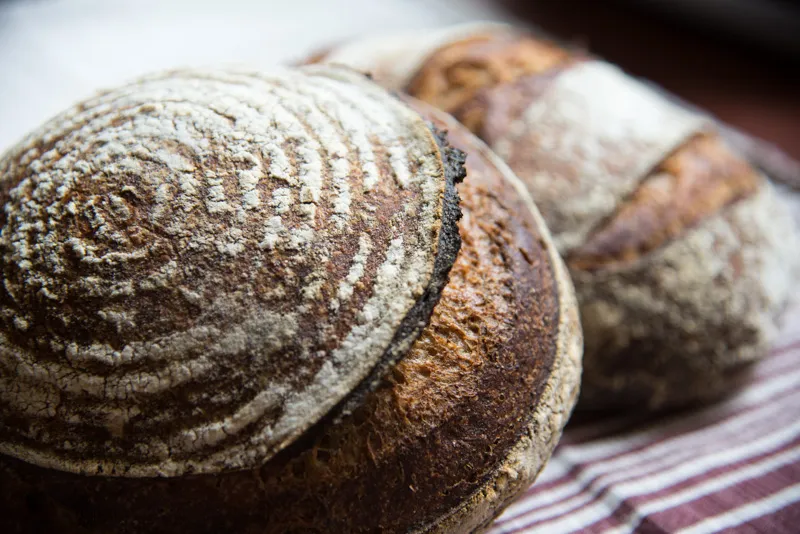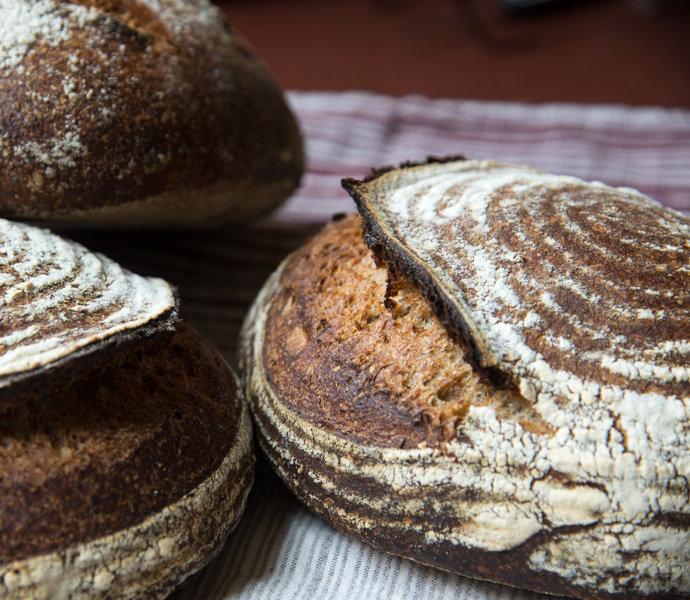
I haven't posted in a while due to a busy travel schedule and family obligations. When I finally returned a few weeks ago I wanted to try out a few formulas from Robertson's latest book, Tartine 3. His combinations of ingredients and use of porridge (think cooked soaker) are very intriguing.
I made a double batch of the wheat-rye-caraway-bread. This has only 10% rye, the rest being a blend of white, high extraction and whole wheat. I was out of high extraction at the time, so I substituted a 50/50 blend of white/WW instead. This is an 85% hydration bread with only 7.5% prefermented flour, so the bulk ferment was long (4-5 hrs at 75˚F). I divided the dough into 6 loaves, roughly 500-600 gm each, and proofed them in brotforms overnight in the refrigerator. The flavor of the ground spices, each 2%, were in the background of the finished loaf, less intense than I expected considering the volume as I was adding it. The crumb was open, although less so compared to his basic country sourdough. It makes a great tasting sandwich bread, and goes surprisingly well with sharp cheddars.



When I first approached the porridge breads I noticed an inconsistency in the book (see post). I made the Rye Porridge bread using a hybrid technique. It was too late to add the porridge to the levain and water mixture, so I added it to the dough directly after the autolyse, but well before the second fold as stated in every porridge recipe in the book. Still, it was difficult to distribute the porridge evenly, and I believe it affected the openness of the crumb somewhat. The flavor was very nutty and had a lot of depth due to the porridge. The crumb was very moist and the crust had a good chewiness.
In the future when I make these porridge breads, and I definitely will, I will add the porridge to the levain prior to the autolyse, as he describes in the Master Formula section of the book. There are so many combination that sound so good, they will keep me busy for a long while.


-Brad
P.S. Here are a few of views of my trip to China and Tibet:









- breadforfun's Blog
- Log in or register to post comments
The bread is very good too. i like the idea of adding the porridge to the levain too and don't like the idea of adding levain to the autolyse - because then it is fermenting and not autolysing :-)
Your bread looks fantastic. - well done and
Happy baking
Adding the levain to the autolyse is one thing I do try to avoid when making bread. The first time I try a new formula I'll make it as written just to see how it behaves. By the second time I'll make it my own. I think Chad Robertson wrote it this way is to simplify it for the home baker, though there is nothing in the book to suggest this.
The trip was great, but there is no good western-style bread in China. They try, but it's all very standard commercial stuff.
-Brad
Beautiful bread and crumb!! Thanks for sharing. Inspires me to keep trying to improve my porridge bread.
Just a question (I know there's probably a thread about this somewhere but can't seem to find it right now): when do you add the levain then if not added at the beginning of mixing? right after autolyse? why and what is the difference? I get the fact that technically fermentation starts when you add the levain. Just wondering what the difference is in the outcome - bread.
Also, you mentioned trying to add the porridge to the levain prior to autolyse. Do you mean to try and distribute it in the leavain and add the mixture to the 'dough' after autolyse? What about trying to 'disolve' the porridge with the levain with water at the autolyse? Just wondering.
Thanks!
It is typical to add the levain immediately after the autolyse, but your question is a good one and I did a little research. According to Emily Buehler in her book Bread Science the autolyse can be done either before of after adding a preferment. Adding it in with the autolyse begins the fermentation process early, as Da mentioned. Longer fermentation results in more flavor developed. But it also starts the protease action of breaking down proteins, which requires a lower pH (i.e., acidic) environment. I think that the upshot is that there has to be enough rising power in the preferment to fully proof the dough before the proteins break down and fail to hold the gluten structure throughout the bake.
In the Master formula in the book he calls for exactly what you suggest: mix the porridge with the levain and water and use that to make the autolyse. I am not sure which will work better - adding the porridge to the autolyse or to the levain. I will test both and see which works better.
-Brad
would disagree with Emily since he was the one who invented the term autolyse and what it means. - dough flour and water only mixed together and allowed to rest - no salt no levain - they were specifically called out to be omitted by the Professor. Pretty simple but well meaning folks over the years forget what the real meaning of words are and invent their own meanings to fit their needs.
That is also my understanding, though I've never read Calvel. I didn't mention that Buehler says that this would be a good way to incorporate and distribute other ingredients, which was the real issue here. I just toss it out as another option, not as the definitive meaning of autolyse.
-Brad
I had the same issue with a recipe from Tartine 3 this past weekend, the porridge portion tended to clump together and I don't know that I ever really got it fully distributed into the dough -- I will try the adding pre-autolyse next time as well and see how that goes.
Really love the dark crust color on loaves in your pictures -- are you doing anything special to get a nice dark bake like that? Dutch oven/baking stone, temp/duration etc?
Cheers!
Appreciate your comments. The Master recipe (p.36) includes a sentence that says to add the porridge to the preferment. I think a Danish dough whisk will help a lot.
The color of the loaves comes from browning of the sugars and proteins in the dough (Maillard reaction). If there are not enough sugars in the dough, which could be caused by either underproofing or overproofing, or if the temperature is too low, they won't brown properly. Caramelization also plays a role with wetter doughs since the reaction requires water.
I don't use a dutch oven because it is too confining shapewise, and it limits the number of loaves I can bake in a single run. I use SylviaH's method of steaming using wet towels, which works very well for me, but it depends on having a well sealed oven. I generally peel the loaves onto a stone heated to 475-500˚F, then add the towels. The steam is removed after several minutes. For these loaves, which were quite cold from the overnight refrigerated retard, steaming can be as long as 16-18 min. to allow expansion to complete. After the steam is removed I change to convection mode and rotate the loaves once. The total bake time was 45-50 min. for 3x600gm loaves in a single bake, and larger loaves would take longer. I will use as high an initial temperature as I can that doesn't burn the bottom of the loaves, and allow enough time for the stone to fully heat up. Hope this is helpful.
-Brad
I did it both ways - once adding the porridge before the autolyse and once after 1 hour (during the 2. fold.). It didn't make the slightest difference.
What I was wondering about is the consistency of the porridge. Robertson gives a ratio flakes : water = 1 : 2. That one size fits all seems very strange.
For the Oatmeal Almond Porridge Bread I had used Ian's (Isand66) ratio of 1 : 2.6 and, also his method to prepare the porridge: "Add 3/4 of the water to rolled oats in small pot over low heat, stirring constantly until all water is absorbed. Add remaining water, 1 g of salt, and keep stirring until porridge is creamy and soft."
For my next loaf, the Barley Flaxseed Porridge Bread I followed exactly Tartine's instructions - even though commonsense and cookbooks told me that different grains absorb different amounts of water:
I simmered 1 portion barley flakes with 2 portions water for 15 minutes. The result, (even though I added more water in between), was so stiff that I had to chop it up in the food processor! It was extremely difficult to work this into the dough without leaving hard lumps!
How can the water amount for all the porridge breads be the same? The flaxseed are very water needy, too!
Apart from that: I love the porridge breads and will bake more in the future.
A comment to the different opinions on autolyse: Peter Reinhart mixes ALL ingredients and let them autolyse, the salt or levain is never added later. I never saw an ill effect of that approach.
Happy baking,
Karin
Hi Karin,
Thanks for your inputs. It is good to know that whenever the porridge is added it has no discernible effect on the final loaf.
It would have been much better to describe the consistency of the porridge rather than a one-size-fits-all formula. The porridge of rye flakes that I made using the 1:2 ratio absorbed all the water in the first few minutes, so I added another 50% water (making it 1:3) and the porridge was still thicker than a 100% rye dough. Other grains and seeds will be certainly be different. Thanks for sharing Ian's technique.
-Brad
A description of the desired consistency of the porridge would have made much more sense. But, fortunately, I managed to squeeze all the porridge lumps flat, and so got rid of most of them.
Making these breads is fun and very rewarding - and sometimes you should rather trust your own commonsense than blindly follow the authorities.
I forgot to mention: your breads turned out great!
Karin
After baking for a while you do develop a sixth sense of how the dough should feel and behave.
-Brad
but porridge to me means oatmeal served for breakfast. Some like it more soupy than others and all grains will absorb water in differing amounts but. I think it you shoot for a porridge consistency or as Janet calls it, 'gruel', I think you won't be far off. It is really just a roux or tang zhong by another name and that is the consistency to shoot for i would think.
I agree Karin, whatever works for people and the experimenting is half the fun. Same goes for the autolyse argument. Doesn't really matter who's right and when to add the levain etc. as long as the outcome is great and we're happy with it. The bread posted above definitely looks awesome and I'm sure it tastes great too. Whatever Brad did it worked!!
I appreciate your comments, suambumeri.
-Brad